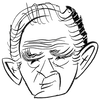User:KWatson/sandbox
 |
Ernest Hemingway and Norman Mailer both wrote fiction and journalisms that deal with what I am calling here the “Reds.” In Hemingway’s For Whom the Bell Tolls and in Mailer’s Harlot’s Ghost and Oswald’s Tale Reds or communists of different types, stripes, and nationalities appear in various significant roles and guises. There are several questions I would like to address, especially the following: What is it that attracted Hemingway and Mailer to write about the Reds? Even if they depict very different historical periods, can we still discern certain commonalities in their approaches to and treatment of the Reds? Further, what is the dominant image of them in the works of Hemingway and Mailer?
The fact that Hemingway and Mailer share a number of common interests and traits is no secret. Both artists dealt extensively and importantly with the horrors of war and with the ways in which people cope with war and conduct themselves in it. Both writers were preoccupied (some might even say obsessed with) macho tests of manhood that in the case of Hemingway involved balls, battles, boxing, bulls, and hunting and fishing. For Mailer balls were also always in play, but he was more of a boxer than a bullfighter, and he was always a battler whatever the arena. A corollary to this is their fascination with the stars and celebrities of American pop culture and with their own stardom and celebrity as well.
Hemingway and Mailer were deeply in love with language, and not just English, as we see in the former’s For Whom the Bell Tolls, which exudes his fondness for Spanish. Mailer studied German assiduously as preparation for writing The Castle in the Forest, and he also worked with Russian in connection with his trips to the Soviet Union, as is evident in Harlot’s Ghost,
page break
Oswald’s Tale, and Castle in the Forest. Their stylistic innovations, well celebrated in Hemingway but not yet fully recognized in Mailer, are no doubt related to this love of language that they shared. Further, neither writer hesitated to tackle the burning issues of the day, in and out of their fiction. Thus, it is no wonder they both engaged with the two most controversial and problematic “isms” of their century, Communism and Fascism.
Before examining For Whom the Bell Tolls it is instructive briefly to consider Hemingway’s relationship to the Spanish Civil War, which he witnessed primarily as a journalist who wrote about the conflict. William Braasch Watson has shown how, in his attitude toward this war, Hemingway moved from a position of complete abhorrence of all war to an ardent supporter of the Republican / Loyalist / Red or Communist cause against the Fascists /Falangists / Francoists, largely under the influence of Jorvis Ivens, an avid Communist and member of the Comintern. Watson comes to the conclusion that in his enthusiasm for the Comintern / Communist cause Hemingway distorted the truth:
<Block|qoute> He suppressed certain realities he knew to be true, and he promoted as realities things he must have known to be false, all in the name of winning a war whose character the Communists had largely defined. In this respect Hemingway had become an effective propagandist . . . . He genuinely admired the Communists for their commitment and for their proven ability to organize and fight the war. But partly too his transformation was the product of a conscious effort on the part of the Communists to gain his confidence and to enlist his support.
